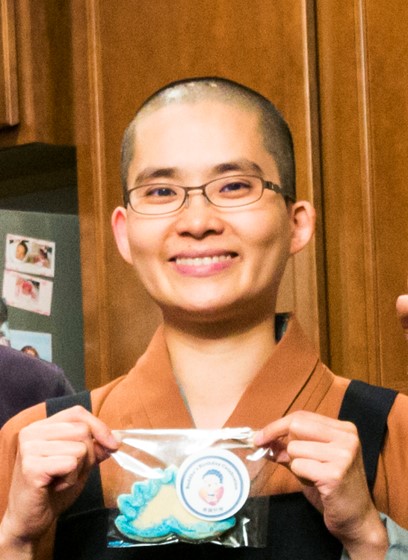
Venerable Jue Huang
Fo Guang Shan St. Louis Buddhist Center
I. Introduction
Auspicious Blessings. I am Venerable Jue Huang from Fo Guang Shan St Louis Buddhist Center. In today’s video, we are going to talk about women in Buddhism, a special group that constitutes half of the four assemblies in Buddhist community. They are Bhiksuni, the fully ordained female monastic, and Upasika, the laywomen. The amount of records on Buddhist women in the Buddha time was disproportionally fewer than the men. But we still could trace their life in Buddhist literature. So let us start first with Bhiksuni, the fully ordained female monastic.
Before we go into it, let us take a look at the 18 arhat statues in Fo Guang Shan Buddha Museum. Unlike the traditional all-male figures of the 18 arhats, there were three female figures included in the ones in Buddha Museum.
Ven. Master Hsing Yun has noticed the fact that even women have been greatly contributed in the Buddhist world, but they were long been underrepresented. The act of putting these female arhats is the attempt to recognize and honor the contribution of women to Buddhist faith and its development. Also, we can make the stories of these great Buddhist women being heard publicly and widely.
So, who are these three extraordinary Buddhist women? I would like to introduce the very first Buddhist woman who made Female Bhiksuni Sangha possible—Mahaprajapati Gotami. You might relate her with our great teacher Gotama Buddha with her last name Gotami. Yes, she is the foster mom and an aunt of the Buddha.
II. The Quest of Mahaprajapati
Mahaprajapati came up a thought of pursuing her spiritual practice after her husband, King Suddhodana, died. But there were not yet a female order under the leadership of the Buddha. Mahaprajapati was the first one asking Buddha to accept women doing spiritual practice under his guidance.
It is not easy to get things started. Mahaprajapati’s request “to go forth” got turndown by the Buddha several times. She was frustrated after several unsuccessful attempts but never gave up.
On her final attempt, she even persuaded 500 women of the Sakya clan to go with her. They shaved head, wore robe and traveled from Kapilavatsu to Vaisali, where the Buddha reside. This trip was approximately 186 miles (300 km) on the Google map. It is equivalent to a trip on foot from London to Manchester in England or a walk from Guang Ming Temple, Orlando, Florida to Miami Fo Guang Shan Temple.
We couldn’t know how many days Mahaprajapati and her companion spent on travelling. But just imagine a lady from a royal family, who had abandoned all she was entitled, walked barefooted for miles in hope for her wish to be fulfilled. And what awaited her was still in the midst of the unknown. This feeling of uncertainty was faithfully recorded in the text:
“Traveling stage by stage, she (Mahāpajāpatī Gotamī) arrived at Vesālī and went to the Great Wood, the hall with the peaked roof. Then Mahāpajāpatī Gotamī stood crying outside the gate, her feet swollen, her limbs covered with dust, miserable and sad, with tearful face.” AN 8.51 Gotamisutta Translated by Bhikkhu Sujato
Luckily, she met Ananda, the attendant of the Buddha, who helped to convince Buddha to accept and ordained women. This is how the Bhiksuni Sangha started.
The reason for Buddha’s hesitancy of accepting the request of women “going forth” is not because they are not capable of getting enlightened and attaining Arhathood. Instead, it is this recognition of quote and quote, “women are the equal of men in terms of spiritual attainment”, that made female order possible.
III. The Voice of Mahaprajapati
Undergone diligent practice, Mahaprajapati finally attained arhathood. Her attainment was recorded in Therigatha, a Theravadin Buddhist text consisting of short poems of early enlightened elder female monastics. The poem is called “A Mother’s Blessing”. It contains 6 stanzas, each stanza has 4 lines.
Buddha! Hero! Praise be to you! You foremost among all beings! You who have released me from pain, And so many other beings too.
(This is the traditional way of Buddhist Literature to start a gatha by praising the Buddha, our respectful teacher.)
All suffering has been understood. The source of craving has withered. Cessation has been touched by me On the noble eight-fold path.
(This is the reflection of her past lives and the state when in the rebirth cycle.)
I've been mother and son before; And father, brother — grandmother too. Not understanding what was real, I flowed-on without finding [peace].
(This is the reflection of her past lives and the state when in the rebirth cycle.)
But now I've seen the Blessed One! This is my last compounded form. The on-flowing of birth has expired. There's no more re-becoming now.
(It is a typical phrase declared by an Arhat from line two to four. This shows the realization of Mahaprajapati.)
See the gathering of followers: Putting forth effort, self controlled, Always with strong resolution —This is how to honor the Buddhas!
(This tells a story of how Buddha teaches Mahaprajapati ways to honor the Buddha. To truly honoring Buddha is not by bowing physically but by practicing the teachings. This is when Mahaprajapati got Buddha’s compliment on being the foremost in respect of broad-mindedness and extensive awareness among both male and female monastic orders.)
Surely for the good of so many Did Maya give birth to Gotama, Who bursts asunder the mass of pain Of those stricken by sickness and death. Thig 6.6 Mahāpajāpatigotamītherīgāthā Translated by Andrew Olendzki
(This Stanza is more personal. It is the memory of her sister giving birth to the Buddha. It leads to the conclusion on how the birth of the Buddha had affected people as well as herself.)
IV. The Farewell of Mahaprajapati
According to Ekottara Agama Chapter 52.1, and Theripadana, the legend of the Their, Mahaprajapati and the 500 Bhiksuni she led also decided to undergo the great release (Parinirvana) after Buddha announced the time of his passing away. Details of how Mahaprajapati bid her last farewell to the Buddha, Ananda, the Sangha and laywomen were recorded in the text. It was warm, dignified, and inspirational.
Her farewell to Buddha was very loving and full of literary expression. It shows feeling of a mother to her son and also making the comparison to the joyfulness of being a disciple to her son. The following stanzas are a few among all for her farewell to Buddha in Mahāpajāpatigotamītherīapadāna (Th Ap 17):
“Well-Gone-One, I am your mother, and you are my father, Hero; Lord, who Gives the Good Teaching’s Joy, O Gotama, I’m born from you. Your body, made of flesh and bones, was reared up by me, Well-Gone-One; my flawless body, made of Truth, was reared up by you, Gotama.” Formerly my eyes and ears weren’t satisfied by the vision of you nor hearing your speech. But now, having obtained perfection, my mind is satisfied by the taste of the Teaching.
Her Farewell to Ananda in Mahāpajāpatigotamītherīapadāna(Th Ap 17):
“O son, keen on serving Buddha, your wisdom’s deep as is the sea, and so you really should not mourn, when the time for smiling has come! Son, through your assistance to me, I have realized nirvana.
(This is to thank Ananda’s willingness to offer instructions and his taking the responsibility of looking after the female order.)
Being requested by you, dear, Buddha gave us ordination. Therefore do not be distressed, son; your effort is now bearing fruit.”
(This is to thank Ananda for persuading the Buddha to agree on establishing female order. She comforted him by dedicating him the result and the fruit of female attainment.)
Her Farewell to Laywomen in Mahāpajāpatigotamītherīapadāna (Th Ap 17):
“My wish I’ve had for very long is finally fulfilled today. This is the time for drums of joy. What then with all these tears, children? If you feel compassion for me, and if you all appreciate the great Teaching’s stability, then strong and fervent you should be.”
(She tried to calm the emotional laywomen by teaching them to focus the Buddha Dharma. It is exactly the same as what she did to Ananda. And it is the proper way of dealing with emotion taught by the Buddha.)
I cannot describe with words how I feel when I was reading this beautiful literature. I was always been moved by the text when preparing this video.
There was a time when I was in my world of imagining being personally present with Mahaprajapati while reading how she bid her last farewell. I heard my name called by Venerable Rugong. Her voice put me back in reality. I was told that a bag of blueberry bleeding its juice in the fridge that had been deep-cleaned a day before. This incident showed a greatest lesson we all need to learn, the impermanence.
We all know impermanence. But wanting things remain unchanged a bit longer has always been the case for a normal people. Things never go the same way as we expected. And the refusal of the changes causes frustration. From the story of Mahaprajapati’s parinirvana, I was able to be calm and mindful while wiping the fridge clean.
The Buddha, along with Nanda, Ananda and Rahula, carried the casket in King Suddhodana’s funeral procession in honor of his royal father. This scene was described in Venerable Master Hsing Yun’s book, The Biography of Sakyamuni Buddha. In the case of Mahaprajapati, Buddha did the same.
After cremation, the Buddha held Mahaprajapati’s sarira with both hands and praised the virtue of this great female Arhat.
"(She had) Practice diligently and attain Arhathood. Entered Emptiness (that is) as pure as the sky What an indescribable great attainment She had accomplished." Taishio 2 No. 145 The Parinirvana of The Buddha’s Mother Translated by Venerable Jue Huang
A stupa was later built and the sarira of this great female Arhat were enshrined by the Lichavi Prince.
Mahaprajapati has possessed all the character of a Buddhist practitioner and her realization of Arhathood set an example for all. The spiritual attainment of her were being praised by the Buddha and the sangha as well. It is the prove of the Teaching, that the spiritual attainment can be realized by both male and female. You too can do so.
V. Conclusion
I would like to conclude this video by sharing the last stanza of Mahāpajāpatigotamītherīapadāna. It is the sermon by our great teacher after his mother’s parinirvana.
“Therefore be lamps unto yourselves; graze in the field of mindfulness. With wisdom’s seven parts* attained, you all should end your suffering.” Mahāpajāpatigotamītherīapadāna(Th Ap 17)
I hope the story of Mahaprajapati inspires you. If you like this video, please subscribe and share. May you find peace and joy in the Dharma. See you next week.
* wisdom’s seven parts (Seven Factors of bodhi): 1. Mindfulness (sati, S. smṛti), 2. Investigation (dhamma vicaya, S. dharmapravicaya), 3. Effort (viriya, S. vīrya), 4. Joy (pīti, S. prīti), 5. Tranquillity (passaddhi, S. praśrabdhi), 6. Concentration/Unification (samādhi, S. samādhi), 7. Equanimity (upekkhā, S. upekṣā). Source: Wikipedia

